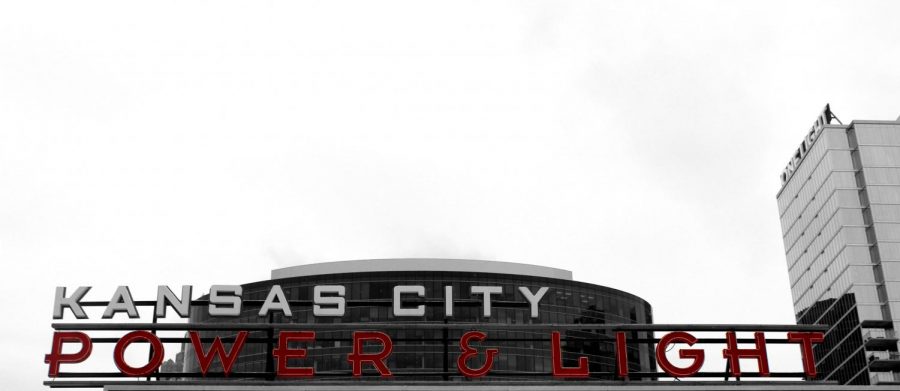A history of Kansas City Power and Light Company
Kansas City’s sole provider of electricity— now a privately-owned, government-regulated utility— began with a pool of $4,000 dollars in 1882.
The Kansas City skyline gives a look into the Power and Light District, with a view of One Light Jan. 30. photo by Maddie Loehr
February 13, 2019
Winter Storm Gia descended in the night, spinning heavy snowflakes into ropes on tree branches and artwork onto glass window panes. According to Kansas City Power and Light Company, it painted Kansas City with up to 11 inches of snow. The morning silence of Saturday, Jan 12., broke to the scrape of metal shovels on cement, an occasional snapping limb and the hum of generators kicking on as power shut down across the city.
A groan rolled out as neighborhoods woke up to find themselves without power the morning that the Chiefs were set to play the Indianapolis Colts at 3:35 p.m., a game that would send them to the AFC Championship. Kansas City wanted its televisions on.
KCP&L had their trucks working to restore power to more than 200,000 customers. It had been the second worst storm in company history, according to the company’s Jan. 16 press release.
Kansas City Power & Light Company is a private, government-regulated utility— the only company in the Kansas City area that generates and delivers power to 47 surrounding counties. Although they have a monopoly over the power grid, social studies teacher Mike Egner says that stiff regulations imposed by the state governments keep prices affordable for homeowners.
Founded in 1882 with a pool of $4,000, the company powered two counties in the Kansas City area. Over the course of the early 20th century, they would acquire several companies, change their name a few times and expand their influence downtown.
J. Ogden Armour bought the then-named Kansas City Electric Light Company in 1900 and operated it in conjunction with his Metropolitan Street Railway Company. In 1916, to detach from the railroad company, it became Kansas City Light & Power Company. Joseph F. Porter was hired as the first company manager while Armour was on his way out of the business in 1917. The company finally settled on the name Kansas City Power & Light in 1922.
Porter expanded the service area from western Missouri to eastern Kansas and commissioned the building of a new headquarters. In 1931, the 32-story Kansas City Power and Light building opened — at the time, the tallest building west of the Mississippi River.
Throughout the mid-1900s, KCP&L incorporated smaller companies and generating stations, including Wolf Creek Generation Station, a nuclear power plant, in 1985.
According to the company website, KCP&L now “serves residential and commercial customers in 47 counties in northwest Missouri and eastern Kansas, an area that covers some 18,000 square miles….Providing safe, reliable and affordable power to our customers is our ongoing priority, as it has been from the very beginning.”
Senior Leah Dorris was one such customer, whose power blew around 5 a.m. Saturday morning. It wouldn’t turn back on for nearly five days. She used her mom’s rewards points to stay at a Holiday Inn as temperatures in her house on Dartmouth St. plummeted into the 30s.
Each day, her mom called KCP&L. Each day they reneged on their word. The power would be on the next day. Next day. Next day.
“It was super stressful,” Dorris said, recalling how she had to throw her groceries into a cooler and leave her cat behind.
Snow totals had topped 10 inches in some parts of the city, according to the National Weather Service. Dorris and her family were just three among 800,000 Kansas City Power and Light customers. Because KCP&L is the only power utility in the 18,000 square-mile service range of Kansas City, they have to be strategic about which lines they choose to repair first.
“They want to repair the lines that affect the most people, and those are in the inner city,” Egner said. “So the people that suffer the most are the people that live in the outlying areas. If somebody lives on a farm and they’re the only one on this stretch of road for a mile, they’re going to get their [power] restored later. Because it takes the same time to restore power to 2,000 people as it does one family.”
Both Egner and Dorris remember the ice storm that placed a week-long paralysis on the city in 2002. Dorris was barely a two year old, and she’s heard her parents recount numerous times what it was like that week; they were moving houses the day the storm hit.
Egner believes that although this most recent storm was less severe, KCP&L is “better off now in 2019 than in 2002 to address those kinds of issues.”




